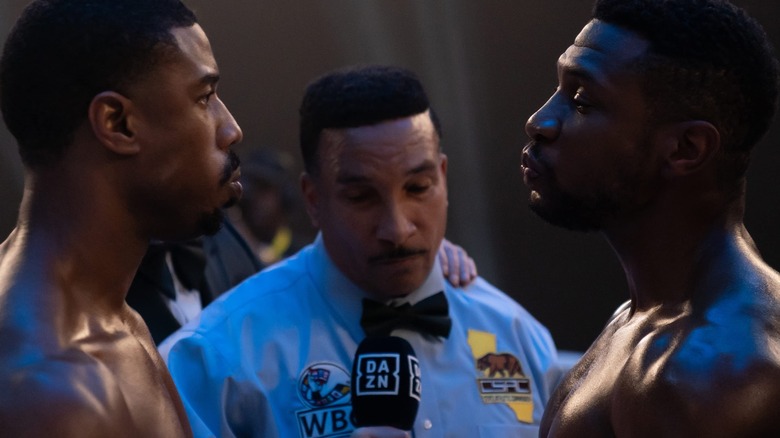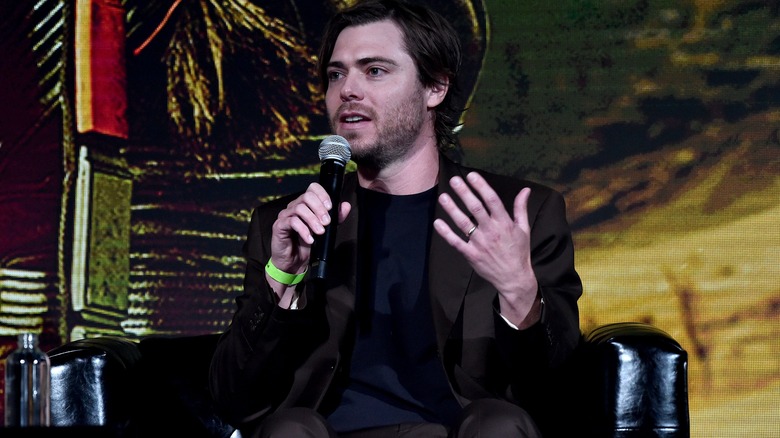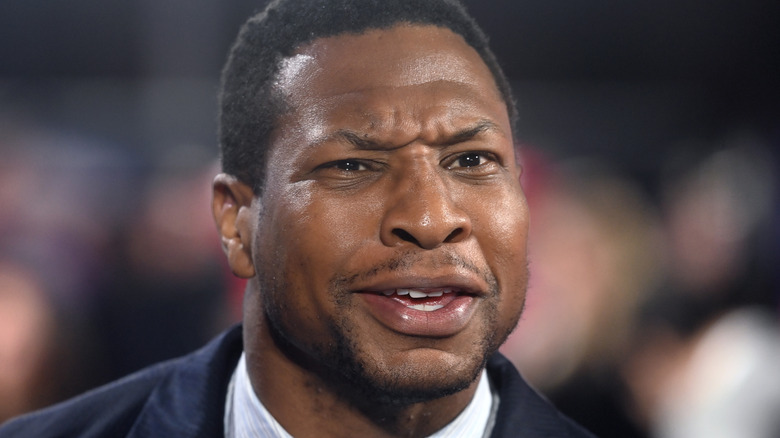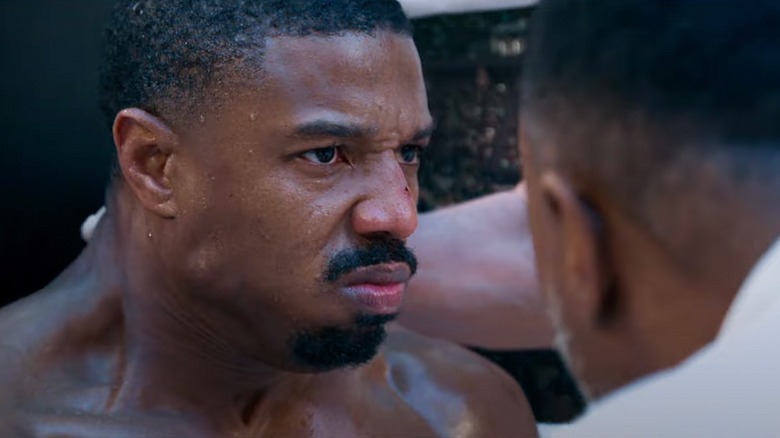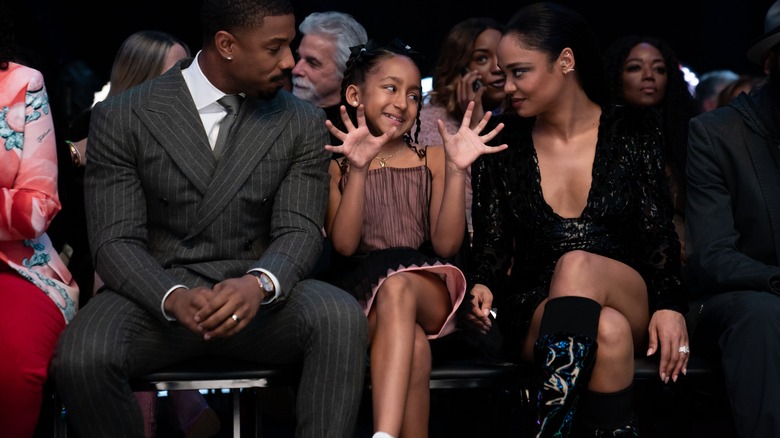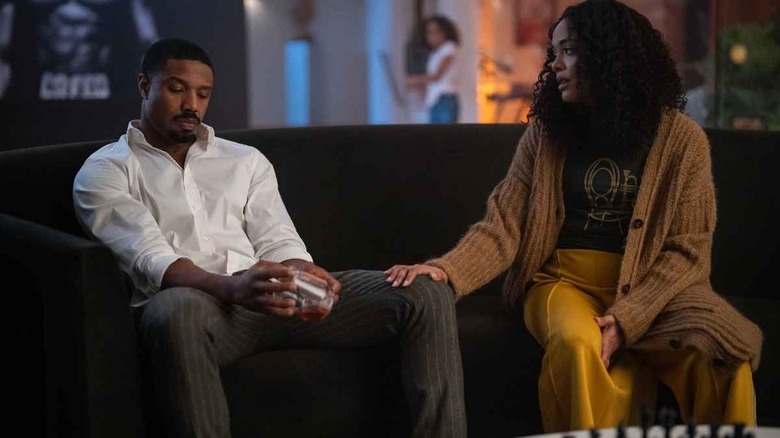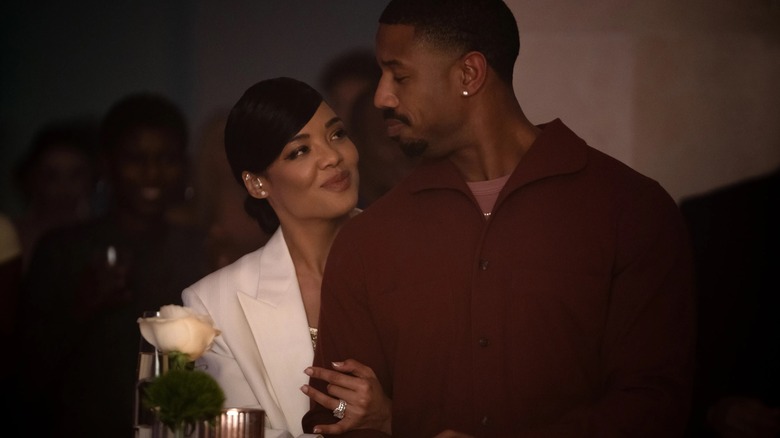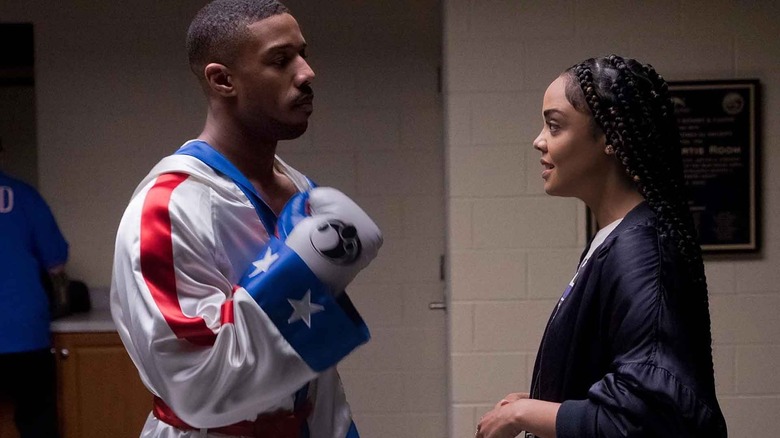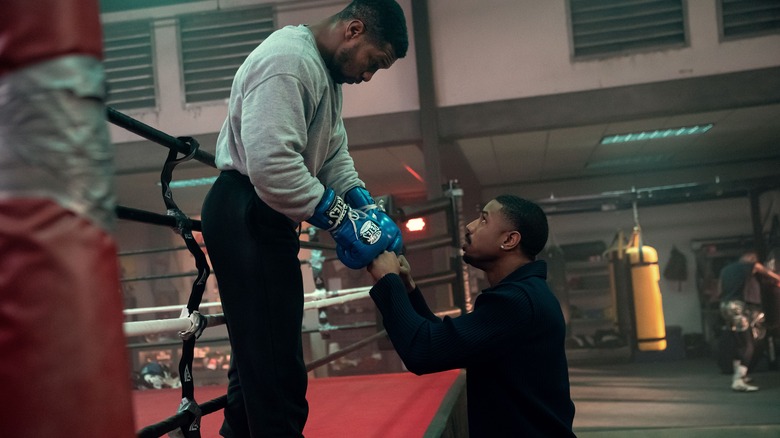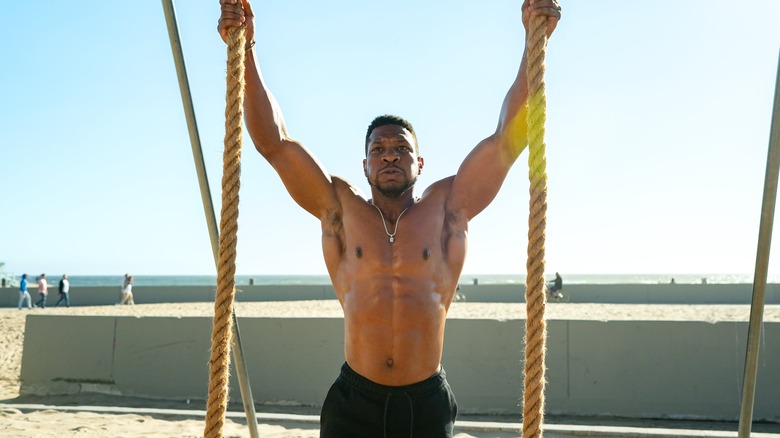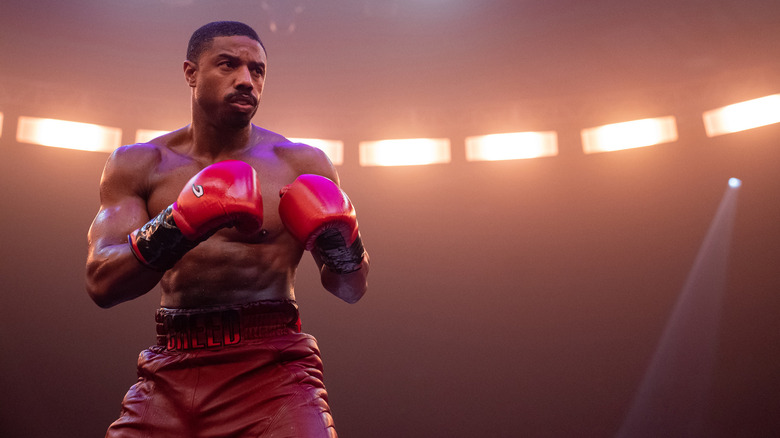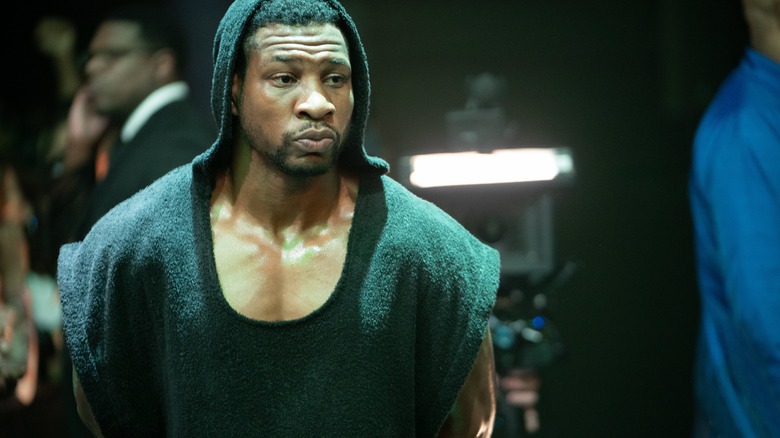Creed III: The 6 Best And 6 Worst Things
With "Creed III," Adonis Creed (Michael B. Jordan) truly comes into his own as a solo act within the "Rocky" universe. Sylvester Stallone's Rocky Balboa is now gone, as are the streets of Philadelphia. The movie belongs to Creed and his universe, including a new rival in the form of former friend Damian "Dame" Anderson (Jonathan Majors). Anderson and Creed were once like brothers, a bond of particular importance since they both grew up as turbulent orphans. Now, as adults, there's an old grudge between the two of them that will require some boxing and, more devastatingly for Creed, a reflection on the past.
"Creed III" is commendably willing to eschew certain hallmarks of the "Rocky" franchise, but it does maintain the saga's impressively enduring ability to get you to stand up and cheer at big boxing matches — even if you're not necessarily a fan of the sport. The commitment of the performers and the sincerity of the movie's heart help make "Creed III" much more than just a rehash of its predecessors.
Of course, just as boxers can't land every punch, neither can "Creed III" nail every single one of the ambitious ideas it's pursuing. There are shortcomings within the motion picture that will keep some from judging it as falling short of the original "Creed," but other moments that transcend. Below, a (spoiler-heavy) blow-by-blow breakdown the worst and best elements of the film.
Worst: The score by Joseph Shirley
While Ludwig Göransson did the scores for the first two "Creed" installments, he opted to sit "Creed III" out. So, composer Joseph Shirley (who is also taking over Göransson's scoring duties on the third season of "The Mandalorian") stepped into the ring.
Having worked in various engineering and programming capacities on the scores of the first two "Creed" movies, Shirley is no stranger to the musical landscape of the franchise. Unfortunately, his compositions in "Creed III" aren't especially memorable and their flaws aren't noticeable just because of comparisons to Göransson's's previous "Creed" scores. Remove Göransson from the equation and the "Creed III" score would still be frustratingly forgettable.
The issues with Shirley's score crystallize at the end of a key sequence where Damian reveals his true malicious colors to Creed at an outdoor party, which ends with Shirley's score crescendoing into a very ominous music cue that could've been lifted from any other movie. While the performances and dialogue in the sequence are fueled by distinct personalities, the score underlining everything is much more generic. Save for some memorable musical flourishes during an especially fantastical stretch of the climactic boxing match, Shirley's score lacks any identity. It's understandable that Göransson couldn't stick with the "Creed" world forever, it's just a shame his successor struggles to be as bold creatively.
Best: Everything involving Jonathan Majors
From "Lovecraft Country" to "Quantumania" to "Creed III," Majors continues to impress. But watch any isolated section of his work in 2019's "The Last Black Man in San Francisco" and you'll see the potential that has had him rising quickly through the pop culture ranks.
He gets to once again excel playing Creed's childhood friend turned rival; Majors crushes this performance on several different levels. For one thing, he's instantly compelling in his screen presence. His initial scenes depicting Anderson reuniting with Creed as an adult effectively communicate such grounded awkwardness and hesitancy. It feels like a very real portrait of a man recently released from a lengthy stint in prison coming to terms with re-entering the world.
When it comes time for him to be a boxing movie antagonist, though, Majors delivers everything you want. His delightfully over-the-top touches, like the way he's practically bouncing off the ground when he approaches a boxing opponent or his taunting "Aloha!" to Creed after they have an argument, shows so much confidence. But Majors injects these entertaining flourishes into Dame without ever losing sight of the achingly human equalities that got viewers invested in the first place. With "Creed III," Majors once again reminds the world why he's a budding star.
Worst: Awkward use of Duke as a mentor
With Sylvester Stallone's Rocky Balboa entirely absent from this film (save for being referenced in one line of dialogue), Adonis Creed is in need of a new mentor figure. This is where Tony "Little Duke" Evers (Wood Harris) comes into play, with the fixture of the previous two "Creed" movies taking over the mentor role in Creed's life. On paper, this makes total sense, not just because Little Duke is a trainer, but because he's the son of Tony "Duke" Evers, a supporting face of the original "Rocky" franchise. Trading one connection to the vintage "Rocky" titles for another makes sense.
Despite a committed performance from Harris, though, Little Duke doesn't quite work as a soaring mentor figure. This is less because the character is innately a bad idea and more that the audience needs those moments of out-of-the-ring bonding to make Creed and Duke's dynamic work.
Since the audience never sees what kind of rapport the characters have when they aren't boxing, it makes Duke feel less like a fleshed-out human being. Because of this, when he's called upon to deliver big lines to Creed in the boxing finale, it doesn't quite hit as it should. While giving Little Duke the mentor role in "Creed III" was a solid concept, its execution is lacking.
Best: The stylized visual touches
Michael B. Jordan makes his directorial debut in "Creed III" and he exhibits a lot of confidence in his filmmaking chops. Throughout the film he drops in small touches (like active camerawork and particularly flamboyant entrances for boxers) that don't necessarily catapult the film out of reality but do give it a more heightened sensibility than its predecessors. That may be the greatest compliment of all about Jordan's filmmaking: he isn't afraid to depart from the visual norms of prior franchise installments.
This willingness to go in such directions is especially apparent in the film's final boxing match, as Creed and Anderson duke it out in a fantasy realm representing their fractured psyches. The audience has vanished, it's only these two now, and their ring is sporadically inhabited by larger-than-life objects representing their internal torment, namely the doors of a jail cell.
It's such an enjoyably larger-than-life way of manifesting the minds of these characters on screen, and unlike anything else in the Rocky" and "Creed" films, that it really makes an impact. Many directors would be too nervous to approach such grand imagery in their directorial effort, especially taking the reigns of a franchise nine films deep. But Jordan embraces the bombastic in an exciting manner with his work behind the camera on "Creed III." Chalk this movie up as a total knockout for establishing Jordan's gifts as a visualist.
Worst: Amara's decreased presence in the second-half of Creed III
One of the early great surprises of "Creed III" is a noteworthy performance delivered by Mila Davis-Kent as Amara, the daughter of Adonis Creed and Bianca Taylor (Tessa Thompson). Davis-Kent is instantly endearing, while the script takes the character down some interesting paths. Chiefly, Amara's proclivity towards resolving conflicts with violence inspires differing parental responses from Creed and Taylor. The former wants his daughters to know how to protect herself while Taylor wants to emphasize alternative forms of figuring out tough issues. It's an intriguing plotline that offers a nice parallel to Creed's struggles to express his internalized trauma.
Unfortunately, the only problem with Amara's character is that she eventually vanishes from long stretches of the movie so that "Creed III" can tackle more traditional sports movie hallmarks (like training montages and big boxing matches). As the storyline shifts from domestic turmoil to boxing rivalries, the interesting sequences depicting Creed being a parent or Amara navigating her life largely vanish. While this makes sense from a narrative structure standpoint, sequences revolving around Amara were so compelling while depictions of the character and her father bonding were immensely moving. It feels like a tragedy that this character couldn't factor more into the later stretches of "Creed III," especially since family is established to be so important to Adonis.
Best: The handling of Creed's backstory
"Creed III" begins with a flashback to adolescent versions of Creed and Anderson going out at night, with the latter character engaging in a tense boxing match. Afterward, the pair stop at a liquor store, where Creed runs into a man named Leon. Upon realizing who this guy is, the young Creed begins beating on Leon; the film then cuts to adult Creed fighting in the boxing ring.
The audience has just glimpsed a formative event from Creed's youth, but only a portion of it. "Creed III" is going to hold the secrets to its protagonist's backstory close to the chest, which is always a risk in a mainstream-friendly title.
Countless features, including recent movies like "Black Adam," have struggled because of an insistence on exploring key character details in non-linear segments. "Creed III," thankfully, pulls this trick off by justifying this approach as a way of demonstrating how Creed himself refuses to fully acknowledge the trauma of his past. He keeps firm boundaries between the past and the modern world, which justifies why audiences would only see bits and pieces of what happened to cause the rupture between Creed and Anderson. Once Creed is finally able to open up midway through "Creed III" on the pain he's lived with in a deeply poignant sequence, the non-linear impulses of the script and its handling of Creed's backstory make total sense.
Worst: The rushed intro to an important emotional scene
Midway through "Creed III," Adonis stops at the convenience store where his life changed forever. This is the spot where he once unleashed so much white-hot rage on Leon their friendship collapsed forever. It's already an important moment — but as Creed is walking down memory lane, he gets a phone call that jostles him into the present. It's Bianca, telling him his adopted mother Mary Anne (Phylicia Rashad) has just experienced a second stroke and that the doctors aren't confident she'll survive.
What follows is one of the most critical, moving sequences of "Creed III," but the bridge between that farewell to Mary Anne and Adonis returning to a key location from his past is incredibly awkward. Tessa Thompson does what she can to make things feel natural with her line deliveries in the phone call voice-over, but it's still such an abrupt shift in tone. Even just giving the space between these two moments in "Creed III" a few more seconds to breathe would've made a world of difference, since, as it stands, it feels like the movie is barreling the audience through to a new pivotal moment of pathos. The moving farewell between Creed and his mother deserved a much-less awkward transition.
Best: Tessa Thompson's performance
On the page, Bianca Taylor isn't an especially critical figure in "Creed III." There is a storyline about her having to give up a singing career in favor of producing music instead, but most of her screen time is dedicated to tugging on Adonis and begging him to finally open up about himself.
Thankfully, the character is portrayed by Tessa Thompson, who couldn't sleepwalk through a role if she tried. In her scenes depicting Taylor navigating both domestic tranquility and strife, Thompson lends an instant credibility to the character. You can feel Taylor's affection for Creed peeking through, even when they're in the middle of a heated argument.
Best of all are the little details Thompson injects into her performance, giving the character a life of her own. This is especially notable in a scene where a singer Taylor is backing performs a song for a large party. As this lady belts out a tune, Taylor is watching her closely, mouthing along to her words in perfect synchronization. Here, Thompson quietly communicates how the performer side of Taylor is still aching to be free. It's a detail entirely divorced from her character's significant other, lending genuine insight into Bianca's interior world. The screenplay for "Creed III" may not have a ton for Bianca Taylor to do, but Thompson amplifies it considerably.
Worst: Creed's ritzy new lifestyle
The original "Rocky" and "Creed" films worked effectively because they focused on working-class people, bringing viewers a true underdog worth for which you want to cheer. These characters boxed because there was no other way to put food on the table; they went home to crummy apartments, and there was a relatability to their surroundings and economic situations not typically found in mainstream movies.
"Creed III" is reminiscent of "Rocky IV" in that it depicts a boxer who has let his fame and money take off his edge. While Adonis may not have bought himself a creepy robot, he now living in a mansion. Having been retired from the boxing game for a few years, Creed's now become a legacy sports figure who racks up big bucks through TV appearances or sponsorship deals. He's now living the comfy life.
It makes sense that Creed would secure such a lavish status, given his successes in the prior two movies. But while this does ensure the character is a direct contrast with Damian Anderson — who just got out of prison with pennies to his name — it's peculiar to have the hero of a "Creed" movie be the rich guy, punching down against the financially impoverished one. "Creed III" may not be demonizing the poor, but this new element in Creed's life still feels a tad disappointing. Creed was once someone worth idolizing and rooting for; he's harder to root for now that he's a member of the bourgeoisie.
Best: That training montage
You know it's coming. This is a sports movie after all, and a part of the "Rocky" franchise to boot. Eventually, "Creed III" is going to have to deliver a training montage.
Much like a shopping montage in a romantic comedy or a reprise in a musical, the training montage is a staple of the sports movie that, when executed with even a smidgen of skill, is pure bliss. Eventually, "Creed III" gets to its sequence in depicting Creed and Anderson training for the final match. The camera is constantly cutting between the two former friends as they push their bodies to the limit, each getting in peak physical condition for this duel.
There's plenty of exhilarating imagery and well-timed cuts in here to keep one's heart racing, and the emphasis on how Creed's body needs work after being out of the boxing game for so long lends formidable stakes. The sight of Anderson climbing up a pair of ropes on the beach, with the blisteringly bright sun cascading off his body, is the peak, a wonderful shot bound to make moviegoers drool and pump their fists in equal measure. But even after that peak shot, capping off the sequence with Creed screaming in triumph above the Hollywood sign is still a grand way to close it all.
Worst: The amusingly outdated product placement
Product placement in sports movies has become increasingly plausible, since in real life, sports stadiums are now typically named for their sponsors and dominated by logos and stickers for big corporations. Even the original "Creed" wasn't immune to product placement outside of the boxing ring, such as a scene where characters are watching their MGM brethren movie "Skyfall."
The most egregious uses of product placement in "Creed III" are as amusing as they are distracting — because of how outdated they are. An extended expository scene meant to be a reflection of Anderson's personal stakes for his first major fight is told through a special airing on Showtime. Clearly, it was all filmed before Showtime underwent a significant branding overhaul.
Also amusing is the use of the Los Angeles sports home for the Lakers and Kings, formerly known as the Staples Center and now dubbed the Crypto.com Arena. Product placement, to some extent, is inevitable in a sports movie. But the most glaring examples of it in "Creed III" feel likely to age as well as milk left on the counter and may prove incomprehensible to future generations.
Best: The final Creed/Anderson scene
"Creed III," like all entries in the "Rocky" franchise, hinges its third-act on a big boxing match, but that's not where this movie leaves everything on the field. After the match, Creed walks in to talk to Anderson in the latter figure's locker room.
This is it. They're finally going to talk about that fateful night years ago, when Creed got into a skirmish with Leon that ended up resulting in Anderson, who leaped in to help Creed, getting arrested by the police. Screenwriters Keenan Coogler and Zach Baylin wisely keep the sequence peppered with various, authentic imperfections. These guys at first don't quite know what to say to one another before the words begin to get pulled from their mouths.
It's a stripped-down, moving sequence that gets so much power from the way its sparseness lets the acting talents of Michael B. Jordan and Jonathan Majors take center-stage. Majors especially excels here, particularly in his delivery of a line where he finally tells Creed that what happened that night years ago wasn't his fault. This is a difficult and intimate conversation, but one that brings far more closure to these men than duking it out in the ring did. It's a lovely capper to the movie that demonstrates the very best of both the film's screenwriters and its leading men.
